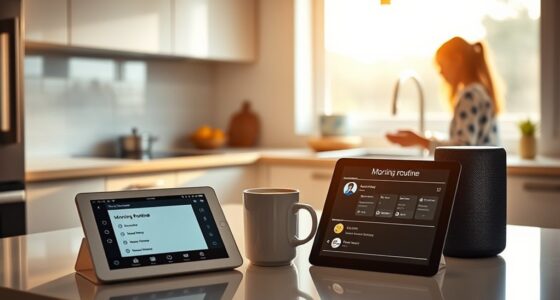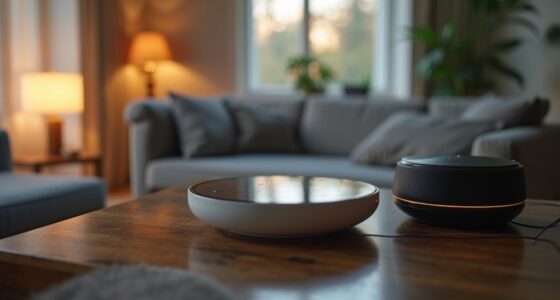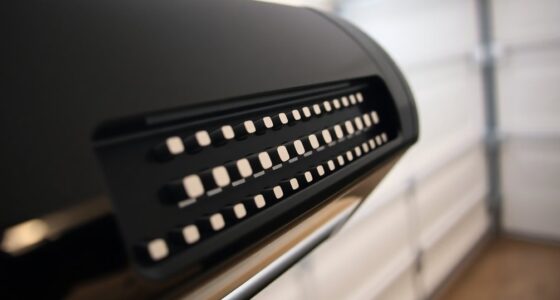The difference between smart relays and PLCs boils down to complexity and application. Smart relays are compact and user-friendly, perfect for simpler tasks like motor control and lighting. They don't require extensive programming skills, making them cost-effective for basic automation. In contrast, PLCs are robust systems built for complex industrial processes. They support advanced programming and multiple input/output tasks, integrating seamlessly with systems like SCADA. While smart relays are great for straightforward needs, PLCs excel in demanding environments. If you want to enhance your understanding of these systems, you might find some intriguing insights ahead.
Key Takeaways
- Smart relays are compact and user-friendly, ideal for simple tasks, while PLCs are robust systems designed for complex industrial processes.
- Programming smart relays is straightforward and accessible for beginners, whereas PLCs require advanced skills and familiarity with complex programming languages.
- Smart relays are more cost-effective and easier to maintain, while PLCs offer advanced diagnostics and integration capabilities for larger automation needs.
- Smart relays excel in small-scale automation like motor control, whereas PLCs are suitable for complex applications like manufacturing and chemical processing.
- Future considerations include evaluating scalability and cost versus adaptability when choosing between smart relays and PLCs for automation strategies.
Overview of Smart Relays and PLCs
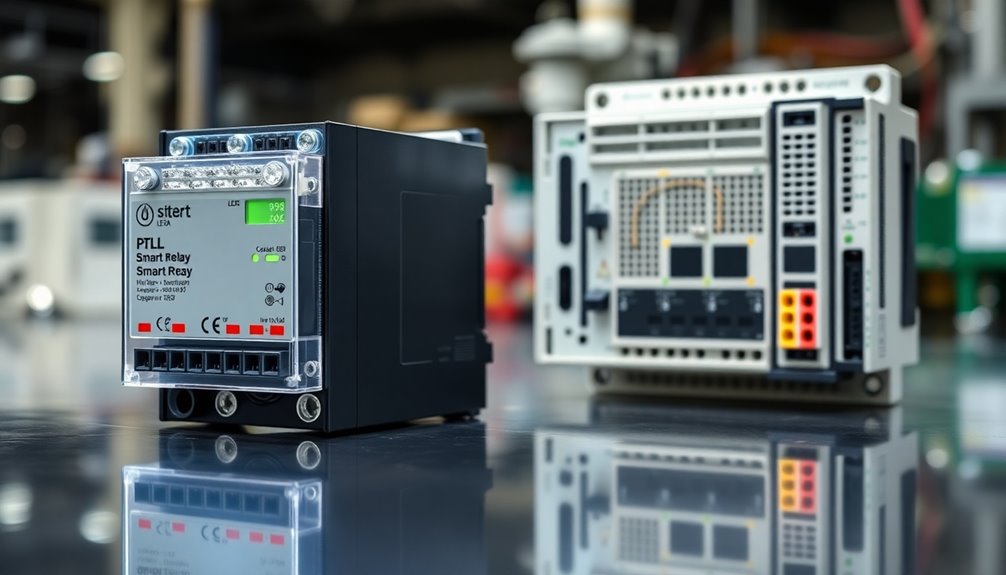
When you look at automation solutions, you'll notice that smart relays and Programmable Logic Controllers (PLCs) serve different purposes.
Smart relays are compact devices ideal for basic control tasks, like motor control and lighting. They typically require minimal programming, making them cost-effective for straightforward automation needs.
In contrast, PLCs are robust systems designed to manage complex industrial processes. They demand advanced programming skills and can handle diverse tasks using multiple programming languages.
While smart relays are limited in integration and diagnostics, PLCs excel in these areas, connecting seamlessly with various systems and offering advanced troubleshooting tools.
Understanding these distinctions helps you choose the right solution for your automation requirements.
Key Differences Between Smart Relays and PLCs
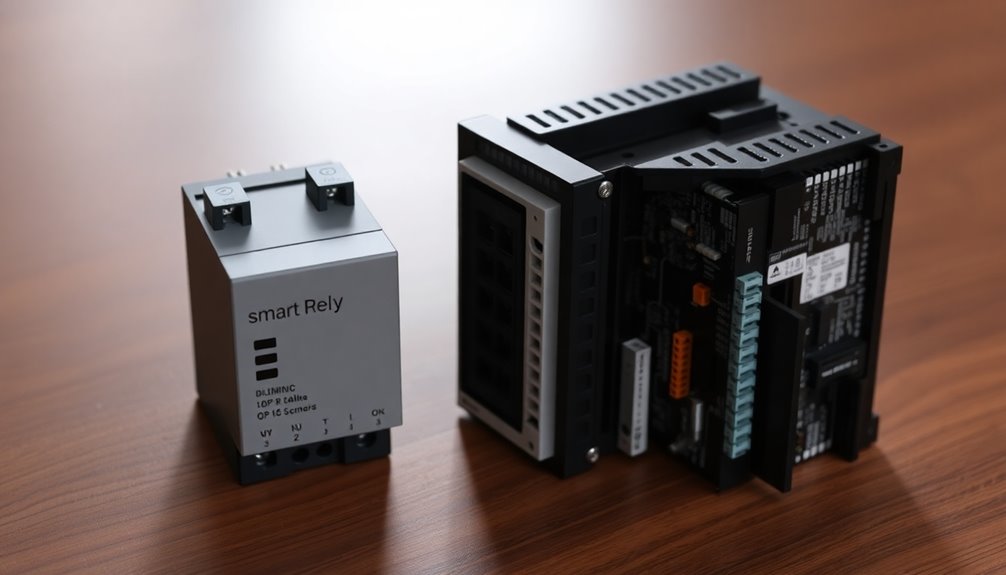
When you're choosing between smart relays and PLCs, size and design play a vital role in your decision-making.
You'll find that smart relays are compact and simpler, while PLCs offer a more robust solution for complex applications.
Understanding their programming complexity and application suitability helps you determine which option fits your needs best.
Size and Design
In the world of automation, size and design play essential roles in determining the right control solution for your needs.
When you're choosing between smart relays and PLCs, keep these key differences in mind:
- Compactness: Smart relays are designed to fit into tight spaces, making them ideal for smaller installations, while PLCs require more physical space due to their modular components.
- Weight: The lightweight nature of smart relays facilitates easier installation, whereas PLC systems are heavier and more substantial.
- Design Focus: Smart relays emphasize simplicity and cost-effectiveness, while PLCs prioritize flexibility and scalability for complex applications.
Choosing the right solution based on size and design can greatly impact your automation project's efficiency.
Programming Complexity
After considering size and design, the programming complexity of smart relays and PLCs becomes a significant factor in your choice.
Smart relays offer user-friendly programming interfaces that make them accessible for beginners. You can often program them without needing dedicated software, which is a huge plus.
In contrast, PLCs require advanced programming skills and familiarity with various programming languages like Ladder Logic, Function Block Diagram, and Structured Text. These languages can be complex to master and typically need specific software and cables.
Additionally, debugging PLCs can be intricate due to their advanced functionalities, while smart relays are straightforward, making them easier to troubleshoot.
If you need basic automation tasks, smart relays might be all you need.
Application Suitability
While smart relays excel in small-scale automation tasks, PLCs are designed for more complex industrial applications.
If you're considering which to use, here are key differences in their application suitability:
- Smart Relays: Best for simple tasks like motor control for pumps and basic lighting systems.
- PLCs: Ideal for intricate processes, such as wastewater treatment and manufacturing, handling multiple inputs and outputs with ease.
- Integration: PLCs support advanced communication protocols and SCADA system integration, making them perfect for environments needing robust control and real-time monitoring.
For straightforward, cost-effective solutions, smart relays shine.
However, when your automation needs evolve, PLCs offer the flexibility and programmability you require.
Choose based on the complexity of your application!
Features of Smart Relays

Smart relays pack a lot of functionality into a compact design, making them perfect for tight spaces.
You'll appreciate their simple programming process, allowing you to set up basic control tasks quickly.
With their basic control capabilities, smart relays offer an efficient solution for straightforward automation needs.
Compact Design Advantage
When you're dealing with limited space in automation projects, the compact design of smart relays becomes a significant advantage.
Unlike bulkier Programmable Logic Controllers (PLCs), smart relays fit seamlessly into tight spots, making them ideal for various applications.
Here are three key benefits of their compact design:
- Easier Integration: Their streamlined form simplifies mounting and reduces installation time.
- Lower Costs: Smart relays are generally more affordable than larger PLC systems, helping you stay within budget.
- Energy Efficiency: Fewer components lead to reduced weight and lower energy consumption.
Simple Programming Process
For those new to automation, the simple programming process of smart relays makes them an appealing choice. Unlike Programmable Logic Controllers (PLCs), which often require complex programming languages like Ladder Logic, smart relays provide user-friendly interfaces that allow for straightforward setup.
You can use function blocks or predefined logic, making it accessible even if you have limited technical expertise. Plus, many smart relays come with free or included programming software, reducing implementation costs.
With quick installation and minimal programming time, they're perfect for users who need rapid deployment for basic automation tasks. Overall, smart relays simplify the programming process, allowing you to focus on what matters most—getting your automation project up and running efficiently.
Basic Control Capabilities
One of the key features of smart relays is their compact design, which allows them to handle basic control tasks efficiently.
These devices are perfect for straightforward automation tasks without the complexities of Programmable Logic Controllers (PLCs). You'll appreciate their ease of use, especially if you're new to automation.
Here are a few basic control capabilities of smart relays:
- Motor Control: Easily manage motors for various applications.
- Lighting Control: Automate lighting systems for enhanced efficiency.
- Simple Process Regulation: Maintain consistent processes with minimal effort.
Additionally, smart relays often require minimal programming and provide wireless control, making them a cost-effective solution for smaller setups.
They're ideal for users seeking reliability in simple scenarios.
Features of PLCs

PLCs, or Programmable Logic Controllers, are essential components in industrial automation, showcasing a range of impressive features. They consist of critical components like a CPU, input/output modules, and a power supply, allowing you to manage multiple tasks at once.
With advanced programming capabilities, including Ladder Logic, Function Block Diagram (FBD), and Structured Text (ST), PLCs adapt to complex automation needs effectively. They also support integration with various systems, such as SCADA and HMIs, providing centralized control and monitoring.
Equipped with advanced diagnostic tools, PLCs make troubleshooting and maintenance easier, enhancing reliability and performance. Plus, their ability to accommodate numerous I/O points and modules guarantees scalability, meeting the growing demands of industrial automation and control.
Advantages of Smart Relays
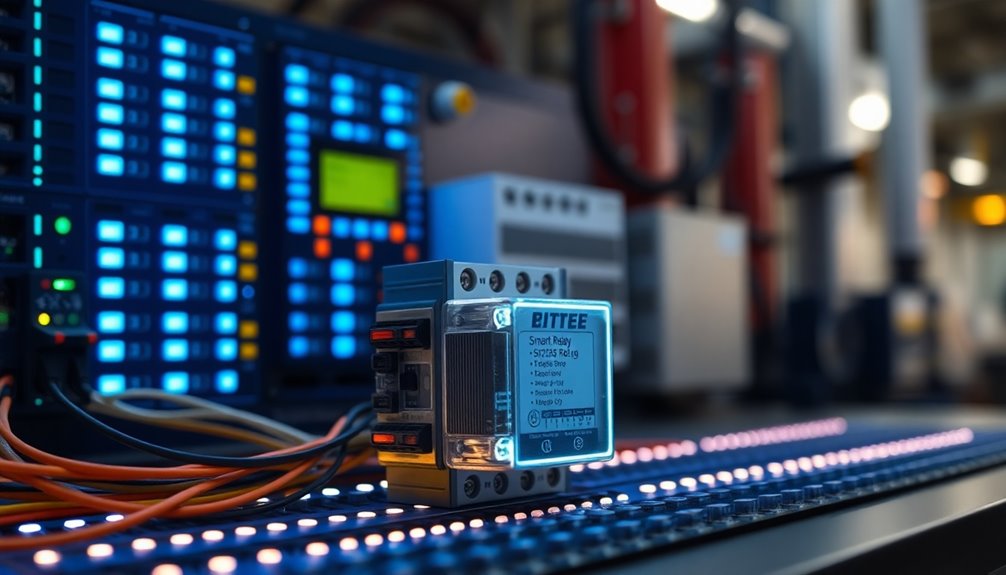
While both smart relays and PLCs play essential roles in automation, smart relays offer distinct advantages that make them appealing for simpler applications.
These compact devices are perfect for tight spaces, allowing for easy installation.
Here are three key benefits of using smart relays:
- Affordability: Smart relays are generally more affordable than PLCs, providing a cost-effective solution for straightforward automation needs.
- Ease of Use: They operate on predefined logic, enabling quick implementation of basic control tasks without needing extensive programming knowledge.
- Lower Maintenance: With reduced maintenance requirements compared to PLCs, smart relays can lead to lower operational costs over time, making them ideal for simple applications.
Incorporating wireless control capabilities enhances convenience and flexibility in your automation scenarios.
Advantages of PLCs
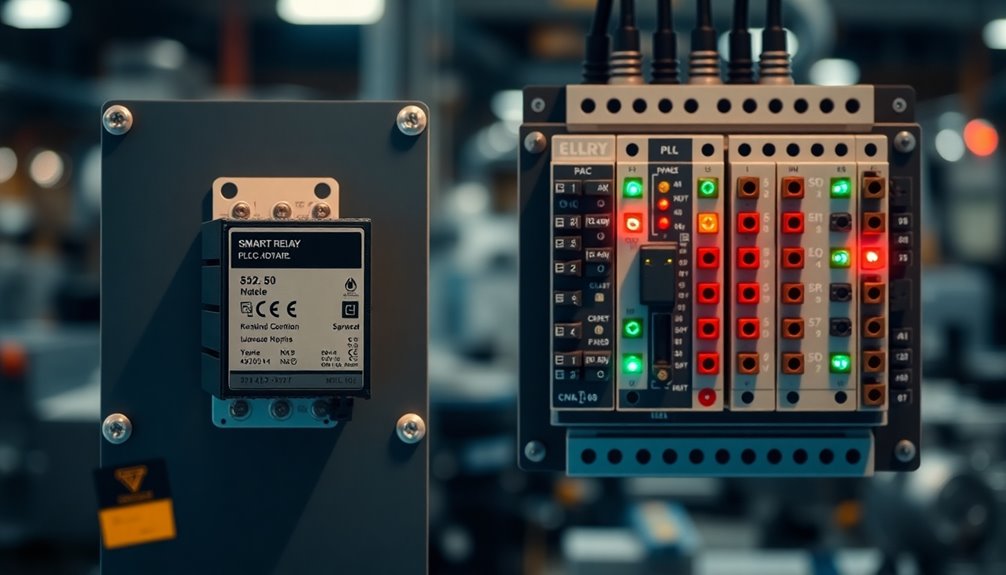
When it comes to complex automation tasks, PLCs stand out for their high adaptability to changing processes, which makes them ideal for a wide range of industrial applications.
You'll appreciate their advanced diagnostic tools, which help you troubleshoot issues efficiently, ensuring minimal downtime.
PLCs also integrate seamlessly with SCADA and HMI systems, allowing for centralized control and monitoring of multiple devices.
Their scalability means you can easily add more modules and I/O points as your automation needs grow.
Plus, with the ability to handle multiple inputs and outputs simultaneously, PLCs excel in real-time monitoring and adjustments, ensuring peak performance even in dynamic environments.
This combination of features makes Programmable Logic Controllers (PLCs) a top choice for industrial automation.
Applications of Smart Relays
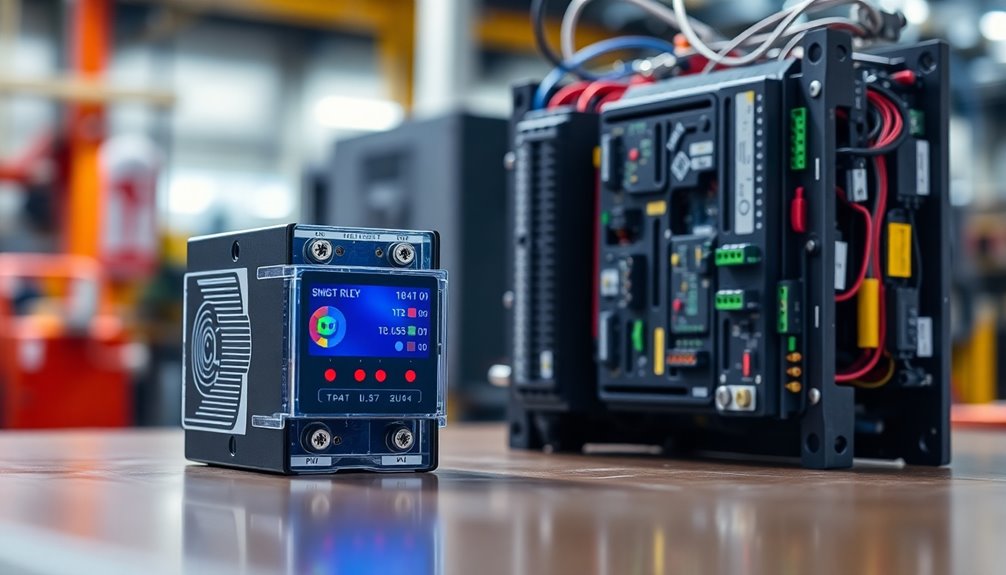
Smart relays find their niche in various applications, especially where simplicity and efficiency are key.
You'll appreciate their versatility in industrial control tasks that require straightforward solutions. Here are three common applications:
- Motor Control: Smart relays are perfect for starting and stopping motors like pumps, fans, and compressors due to their compact design and user-friendly operation.
- Lighting Control: In industrial and commercial buildings, they provide easy on/off functionality, eliminating the need for complicated programming.
- Process Control: They effectively manage basic processes, such as temperature regulation in ovens and furnaces, ensuring reliability in automation tasks.
With their cost-effective nature and ability to fit into tight spaces, smart relays are a smart choice for small-scale automation projects.
Applications of PLCs

In industrial environments where tasks become more complex, PLCs (Programmable Logic Controllers) emerge as an essential solution. You'll find PLCs widely utilized in manufacturing processes, assembly lines, and intricate industrial automation. They effectively integrate with advanced systems like SCADA for real-time monitoring and control of industrial processes.
| Industry | Application |
|---|---|
| Manufacturing | Assembly lines and processes |
| Chemical & Oil/Gas | Process manufacturing |
| Wastewater Treatment | Regulatory compliance management |
| Packaging | Filling, sealing, and labeling |
| Automation | Complex control systems |
PLCs are more complex than simpler control systems, allowing for precise control and safety management in various applications.
Future Considerations for Automation
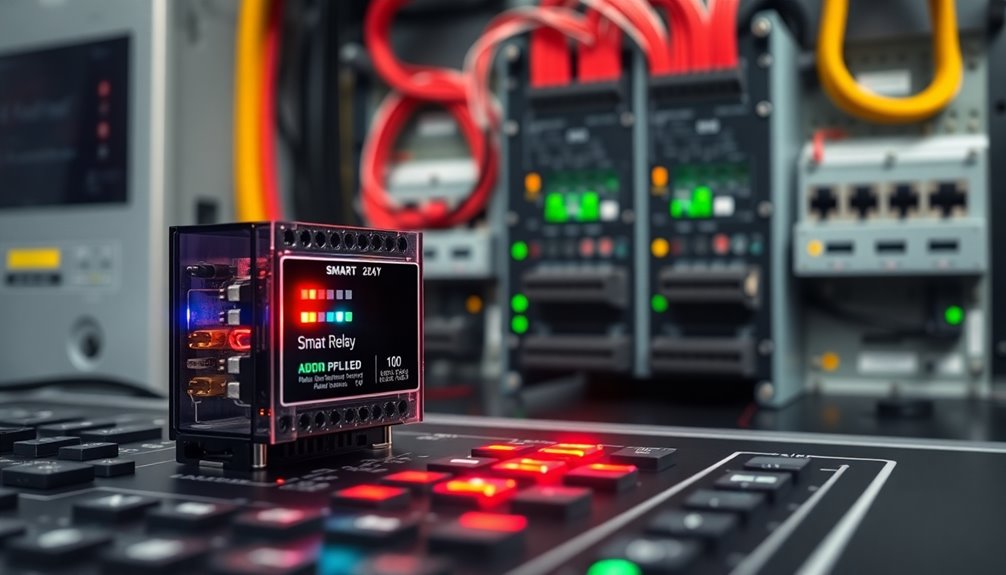
As automation technology continues to evolve, it's crucial to anticipate future needs and challenges in your operations.
When planning for the future, consider these key factors:
- Scalability: Smart relays mightn't handle your growing processes, so think about how your systems will adapt over time.
- Cost vs. Adaptability: While smart relays may save you money now, investing in Programmable Logic Controllers (PLCs) could offer long-term benefits for complex automation.
- Regular Assessments: Continuously evaluate your automation strategies to guarantee they can adapt to changing technologies and operational goals.
Frequently Asked Questions
What Is the Difference Between PLC and Smart Relay?
When you're looking at PLCs and smart relays, you'll find key differences in their capabilities.
Smart relays are compact and user-friendly, making them great for simple tasks. In contrast, PLCs are more complex and can handle intricate processes.
While smart relays require minimal programming, PLCs need advanced skills.
Cost-wise, smart relays are affordable for small projects, but PLCs offer scalability for larger, evolving automation needs.
Choose based on your project requirements!
What Is the Difference Between PLC and Automation?
When you think about PLCs and automation, you're really looking at how PLCs serve as the brains behind automated systems. They control and manage various processes, ensuring everything runs smoothly and efficiently.
While automation involves using technology to perform tasks with minimal human intervention, PLCs provide the flexibility and precision needed for complex operations.
Knowing how they fit into the broader automation landscape can help you choose the right solution for your needs.
What Is a Smart Relay?
Imagine a tiny conductor orchestrating a symphony of machines. That's a smart relay for you.
It's a compact automation device that helps you control simple processes with ease. You don't need to be a programming whiz; its user-friendly interface lets you set up logic quickly.
With wireless capabilities, you can connect it to other devices, making it perfect for tasks like motor control and lighting management in your projects.
Why Is PLC Better Than Relay?
When you compare PLCs and relays, you'll find that PLCs offer greater programmability and flexibility.
They can handle complex tasks, support multiple devices, and allow for real-time monitoring.
You'll benefit from enhanced diagnostics and scalability, making PLCs a better fit for evolving automation needs.
While the initial costs might be higher, their adaptability and efficiency often lead to a better long-term return on investment compared to simpler relays.
Conclusion
In choosing between smart relays and PLCs, consider your specific needs. If you're after simplicity, cost-effectiveness, and quick setups, smart relays might be your best bet. If you require flexibility, scalability, and complex control, then PLCs are the way to go. Both have their unique strengths, serving different purposes in automation. Ultimately, it's about finding the right fit for your project, enhancing efficiency, and driving innovation in your operations.


